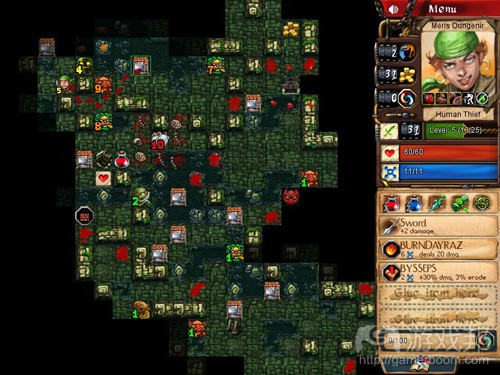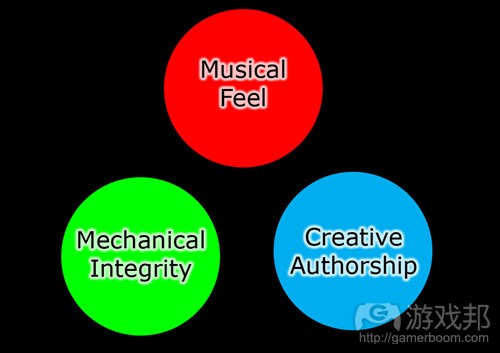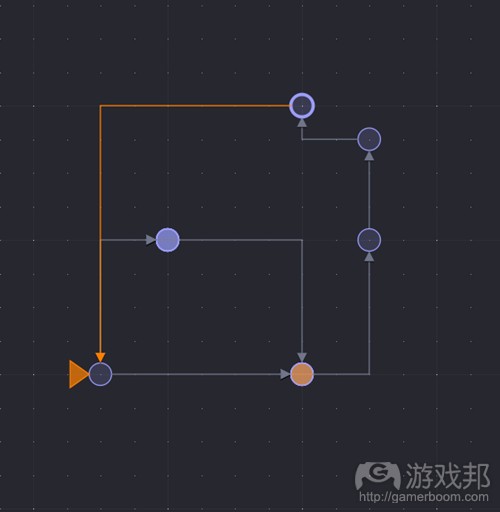分享处理音频谜题设计的方法
作者:Rodain Joubert
在我作为游戏设计师的时候,我最棒的项目通常是最具有确定性和逻辑乐趣:伴随着基于回合的机制,有意义的选择,可量化的规则集的游戏。在我的游戏中没有多少“感觉”空间,因为我认为左脑的运转会将玩家彻底吞噬。当然了,游戏中总是存在装饰品,界面调整以及其它感觉元素的真实空间,只是我所面对的整体游戏更倾向于包含如下的内容:
不久前,我意识到自己渴望看到严格的机制密度,而良好的平衡与谜题设计硬性法则非常适合受机制驱动的项目,如《桌面地下城》,但我并未专注于创造自己所谓的“性感”游戏:像《旅程》那样具有让人惊艳的行动场景,及其逼真的物理模拟器和直接的情感体验。我从未发行过一款是围绕于像音乐等审美元素的游戏(尽管我总是会对《桌面地下城》的配音感到自豪)。
所以我便开始追寻一些关于游戏感觉的讨论,并在网上寻找人们对此的看法。我知道了Steve Swink,认识了许多Thatgamecompany所谓的“感觉工程师”,并从那些专注于整合游戏体验去激发特别情感的开发者身上获得了许多灵感。
考虑到自己的能力限制,我不知道自己是否能够在所处区域内开始实践“感觉”理念,创造出既保留着强大的机制同时能够提供一些情感价值的小游戏。在游戏感觉领域中,我的最大妥协便是名为《Stoic》的原型,这是针对于良好的战斗流的10%代码功能与90%的调整。游戏本身是基于回合制:而重玩的设计是为了呈现我能够管理的敬畏感和壮观场景。
《Stoic》教会我的最重要的事便是平衡优秀的机制与良好的感觉之间的复杂性。在开发原型的过程中,我所作出的每个调整都将在这个区域中迈进一部,但却也是在向其它区域进行妥协。我所涉及的最佳“机制”战斗是静态且不能鼓舞人心的,而我为了让行动变得更棒而付出的努力已经开始侵蚀规则集的完整性。
很快地我将这一教训带到了音频领域,为一款名为《Cadence》且受谜题驱动的音乐沙盒游戏进行设计。我的搭档是来自南非的开发者Peter Cardwell-Gardner,《Cadence》是我当下所致力于的项目,因为它能够提供给我一些有价值的机遇,让我能够基于某些有趣的方式去发挥自己的设计哲理,特别是在音频方面。这也帮助项目的领导者能够对自己的游戏拥有比我更敏锐的审美价值感观(以及实际的声音制作体验)。
不管你是否有时间去观看一个游戏玩法视频,设计协议便是:我认为音频游戏拥有一些不可避免的难度,这能帮我协调一些重要性的理念,《Cadence》传达了一个谜题基础和潜能去处理这一问题。这能够为一个出色的音乐项目设想目标,就像一场三向拔河赛一样:
任何音乐项目的一个核心价值便是其音乐感。游戏中的感觉通常都被用于描述更加广泛的需求,但我们能够讨论游戏所生成的声音能在这种类型中创造或破坏某些元素。这是位于你的游戏的机制和情感回报的核心。大多数认真的音频项目都致力于更好地传达这种感觉。
机制完整性是谜题,游戏或与音乐无关的情境的价值所在。为了更清楚地想象这种情况,请问问你自己:如果音乐被切断了,那么一款特定游戏的“左脑”挑战到底会多有趣?有价值且吸引人?或者是肤浅并且一点都不有趣?一款带有机制完整性的音频游戏便是一款你既期待能够看到谜题同时还拥有音乐输出的游戏。音乐能够激发你的感觉,而机制能够让你感受到机智与挑战。
最终类别便是创造性自由以及对于挑战和情境输出内容的控制感。在这种情况下,我认为任何音频输出内容都是源自玩家的行动。这是最棘手的要求,因为完成它的同时也伴随着一些内在劣势。预先设定好的声音和设备能够有效地呈现让人惊叹的旋律,但却不能提供真正的拥有感—-音乐是真的属于玩家。另一方面,提供给玩家对于“声音解决方法”过多的控制权将导致他们缺乏引导和动机去创造真正优秀的音乐—-或者更直接地说便是,人们将很容易创造出听起来很奇怪的内容,从而让他们难以获得满足。
追求任何这些目标将有可能破坏其它目标,至少在我理解中是这样的。似乎在《Stoic》中我遭遇了三种形式的挑战,这也许是开发者为了创造一款优秀的音乐游戏而整合各种类型的声音游戏的原因之一。我将使用其中的一些游戏进行比较:
1.《Auditorium》
作为我当下最喜欢的一款游戏,《Auditorium》是那些真正重视机制的同时还维持着高水平感觉的优秀游戏之一。游戏中的谜题很巧妙也很有趣,但其视听之旅和主题结构使整款游戏显得更加吸引人。也就是说,对于音乐的拥有感是局限于调整你的谜题解决方法的过程(从其自身看来这是一次让人满足的过程)。音乐输出是精心策划过的,所以我认为在这一列表中,《Auditorium》相比其它游戏拥有较少的创造性自由。
2.《FRACT OSC》
这款游戏在某一段时间是最受欢迎的一款声音游戏。作为一款独立游戏,它有能力去处理我们的三个设计目标。对于我来说游戏的谜题有点参差不齐,尽管我很欣赏灯光–管子–压力–改向。它的感觉很棒—-从根本上看来就是音乐版的《神秘岛》。此外,拥有感被受限于调整过程中,就像《Auditorium》那样作为预先设定好的最终产品。这也是依赖于玩家为了游戏去创造自己的技能,尽管对于我来说去考虑它是否等同于带有一个开放解决空间的谜题太过于长远。
3.《Circuits》
《Circuits》是一个纯粹的音乐之梦,它最大程度地强调感觉,并拥有我非常欣赏的精致包。这是少数我会故意去探索错误的解决方法只为听到不同声音结合的游戏之一。不幸的是,其谜题的核心是听力测试,游戏并未真正包含足够的逻辑挑战。虽然对于游戏风格感到失望,但游戏却非常接近优秀的游戏感,让你觉得自己就像在玩听绝版的乐高一样。游戏并未明确说明其机制挑战,即允许你略过任何你想略过的关卡,这是我既钦佩又讨厌的一点。
4.《吉他英雄》
虽然我提到了这系列游戏,但是这里的字句是用于整体的“音乐同步”游戏。这些音乐游戏很难真正具有创造性空间,因为它们通常只是在测试韵律,或者像在《音乐战机》中匹配预设好的音轨。它们拥有非常棒的感觉并具有机制优越感或满足感,尽管玩家最终失去了所有感。
5.“Nodal”
首先,这并不是一款真正的游戏。Nodal其实是类似于《Cadence》的核心节点结构的音频控制器。它为呈现出感觉而具有安慰点,因为作为一个功能音乐生成器,它尝试着改造人们想象他们所创造的音乐的方式(游戏邦注:这个项目的创造性所有权是绝对的10/10)。所以这真的是一个带有机制基础的优秀理念,虽然这并不是真正的游戏,但却是一个非常棒的学习对象。这是一个项目如何通过区分设计目标与相似的内容区别开来的一个例子。
我希望这些内容能够呈现出音频项目的多样性。因为这三个设计元素间的自然竞争性,不同的项目基于更加多样的方式不断地堆积着这些缺口,并对音频游戏领域的整体多样性做出更大的贡献。
(本文为游戏邦/gamerboom.com编译,拒绝任何不保留版权的转载,如需转载请联系:游戏邦)
Approaching Audio Puzzle Design (pt 1)
by Rodain Joubert
In my existence as a game designer, my best projects tend to be as deterministic and logically interesting as possible: games with turn-based mechanics, meaningful choices and quantifiable rulesets (and nothing where nuanced physics apply, thanks). There’s little room for “feel” in my games, since I think mainly about the left-brained engagements swallowing my players whole. Sure, there’s always realistic room for cosmetics, interface tweaks and other feel elements, but overall the games I work on tend to embody something like this:
All hail information density!
A short while ago, I realised that my desire for rigid mechanical precision and the hard laws of good balance and puzzle designs were great for hectically mechanic-driven projects such as Desktop Dungeons, but that I’d paid scant attention to creating what I call “sexy” games: wow-inducing action spectacles, gut-feel physics simulators and directly emotive experiences like Journey. I’d certainly never released a game hinging on some aesthetic like music (though I’m always vicariously proud of the Desktop Dungeons soundtrack).
So I started following the discussion on game feel, quietly poking at one or two corners of the Internet where people were buzzing about it. I learned about Steve Swink, read more into what Thatgamecompany calls “feel engineers” and drew inspiration from fellow developers who focused on engrossing game experiences to inspire particular emotions.
Given the limits of my capabilities, I wondered if I could start practicing the general idea of “feel” within my own realm, creating games that remained fiercely mechanical while still offering some sense of flow and emotive value. My best compromise in the area of game feel was a prototype called Stoic, which was 10% coding functionality and 90% tweaking for good combat flow. The game itself was turn-based: the replays, however, were designed for as much awe and spectacle as I could manage.
The most important thing Stoic taught me was the difficulty of balancing good mechanics against good feel. In the course of developing the prototype, practically every adjustment I made would further one area but compromise another. The best “mechanical” combat I could devise was static and uninspiring to look at, but a lot of my efforts at making the action look better would start to erode the ruleset’s integrity.
I took this lesson with me to the audio arena soon afterwards, approaching the design for a puzzle-driven musical sandbox called Cadence. A brainchild of fellow South African developer Peter Cardwell-Gardner, Cadence is the project I’m working on at the moment because it provides me with several valuable opportunities to apply my design philosophy in interesting ways, especially for audio. And it helps that the project’s lead has a far more keenly developed sense of aesthetic value for his games than I do (as well as actual sound production experience).
Regardless of whether you have the time to watch a gameplay video, the design deal is this: I think that audio games have a somewhat inevitable difficulty harmonising several concepts of importance to me, and Cadence sports a puzzle foundation with the potential to address that. It helps to envision the goals for a good music project as being a three-way tug-of-war:
One of the core values of any musical project will be its musical feel. Feel in games is generally used to describe a much broader set of requirements, but it’s safe to argue that the sound the game generates will be the make-or-break factor in this sort of genre. It’s at the centre of your game’s mechanical and emotional payoffs. Most serious audio projects aim to do feel as well as possible.
Mechanical integrity is the value of the puzzle, game or situation independently of the music. To envision this most clearly, ask yourself: how interesting would a given game’s “left brain” challenges be if the music were to be switched off? Rewarding and engaging, or shallow and uninteresting? An audio game with mechanical integrity would be one where, in my books, you look forward to the puzzles as much as you do their musical output. Music helps you feel inspired, but mechanics help you feel smart and challenged.
The final category is creative freedom and the ability to feel authorship over the output of challenges and situations. In this case, I consider the output to be whatever audio is generated by the player’s actions. This can be the most thorny requirement because fulfilling it comes with inherent disadvantages. Pre-scripted sounds and devices do well to present awe-inspiring melodies, but don’t really give true feelings of ownership – the music really belonging to the player. On the other hand, giving players too much control over the “sound solution” can leave them without the guidance or incentive to make especially good music – or to put it more bluntly, it’s easy for people to make stuff that sounds awful and leaves them dissatisfied.
Pursuing any one of these goals tends to be disruptive of the others, at least in my understanding. It feels like a three-way split of the challenge I encountered with Stoic and it may be one of the reasons developers tend to embrace an astounding variety of sound game “styles” in their search for a great musical game. I’ll use a few for comparison:
1: Auditorium
Probably my personal favourite at the moment, Auditorium is one of those gems which puts true priority on mechanics while maintaining a high level of feel. The puzzles are clever and interesting on their own, but feel enhanced by the audiovisual journey and thematic structure of the game. That said, feelings of ownership over the music are limited to the process of tweaking your puzzle solution (which is nonetheless a satisfying journey in itself). The musical output is otherwise quite curated and I would describe Auditorium as having less creative freedom than others in this list.
2: FRACT OSC
Easily the biggest sound game out in a while, and I’m speaking quite literally about its scope. An indie game this massive has the capability to address all three of our design goals quite well. The puzzles are a mixed bag for me, though I utterly adore the light-tube-pipe-pressure-redirect ones (an elegant term, I deem it). And its feel is great – basically a musical Myst. Otherwise, authorship is confined to the tweaking process, with a pre-determined end product as with Auditorium. It’s also dependent on players building up their skills for the “live-fire” studio attached to the game, though that’s a little too meta and long-term for me to consider it equivalent to puzzles with an open solution space.
3: Circuits
Circuits is a purist musical dream, cranking feel to the max in a tight, elegant package that I cannot help but respect. It’s one of the few games where I’ll deliberately explore wrong solutions to hear different sound combinations. Unfortunately, the core of its puzzles are listening tests, and the game doesn’t actually include much logical challenge. Disappointing for a gaming style like mine, but really close to the feeling of good music and the sense that you’re playing with a sort of aural Lego. The game is so agnostic about its mechanical challenges that it actually allows you to skip levels whenever you want, which I both admire and hate.
4: Any Guitar Hero stuff
I mention this series, but the words here apply to “play-along” games in general. It’s difficult for these music games to really have much creative room since they’re really just testing rhythm, or matching up with preset tracks as in Audiosurf. They can have a great feel and tend to be mechanically superior or more satisfying (as well as great skill builders), though players lose out hard on the authorship front as a consequence.
5: Nodal
Ha, okay, first: not a game. Nodal is actually an audio controller resembling the core node-edge structure of Cadence. It gets consolation points for feel, because as a functional music generator it actually attempts to reinvent people’s way of envisioning the music they’re making (and this project’s creative authorship is, of course, a solid 10/10). So it’s a really cool idea with a mechanical base that’s not actually game-suitable, but nonetheless a good study. This is one example of how a project can be separated from similar ones by its differing design goals.
I hope this smattering shows a respectable diversity of audio projects with the lens I’ve provided. Due to the natural competition among these three design elements, different projects stack these chips in rather diverse ways, contributing towards overall variety in the audio game scene.
In my next writeup, I’ll go a little more into where I think Cadence sits with these three categories, how I hope to refine its mechanical base to match its feel more closely, and how I keep my head above the water by using my work partner’s sound experience to inform the game’s design evolution from here.(source:gamasutra)
下一篇:解析游戏中的4种主要微交易类型












































 闽公网安备35020302001549号
闽公网安备35020302001549号